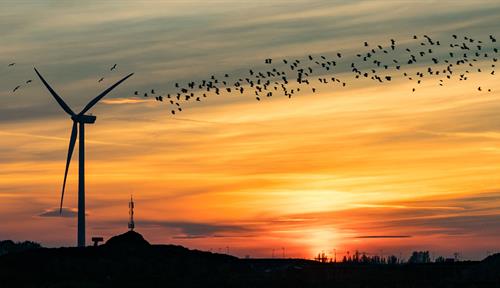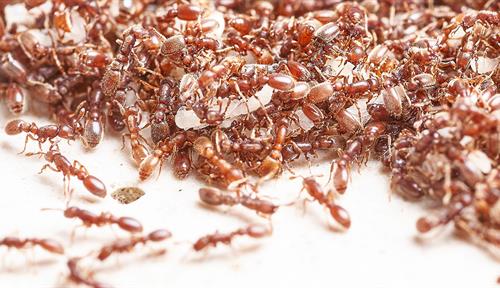How shade coffee lends conservation a hand
When managed in the right way, the farms that provide our morning brew can be a refuge for plant and animal biodiversity
Support sound science and smart stories
Help us make scientific knowledge accessible to all
Donate today
Up in the highlands of the Ethiopian plateau grows a tree with bright red fruit that came to profoundly shape morning rituals for people all over the world. Those little fruits — also known as cherries — contain seeds that after harvesting, processing and roasting, turn into coffee beans.
In their native land, coffee trees typically grow in the understory of tropical forests. And not surprisingly, people first cultivated the plants in the shade, re-creating their natural environment. That practice persisted even after coffee production spread around the globe, and eventually a mosaic of several production types emerged, with shade featured in all but one.
At one end of the spectrum, “rustic” or “mountain” production planted coffee on the forest floor under existing tree cover — a system adopted by some local communities and Indigenous groups, with minimal use of pesticides.
Traditional, slightly more managed polycultures created “coffee gardens” in the forest by keeping or adding useful plants such as food crops or ones with medicinal value. Commercial polycultures also sprang up, which removed the forest but mimicked it, planting coffee beneath useful canopy trees such as rubber and cedar.
As coffee production intensified, shaded monocultures came on the scene, with one species of tree as the canopy. Finally, by the mid-1980s and 1990s, unshaded monocultures emerged, which operate like many modern agricultural enterprises: intensively managed with plenty of synthetic fertilizers and herbicides.
But in recent decades, with growing concern about steep declines in biodiversity, there has been renewed interest in the value of coffee grown in the shade. The latitudes where coffee is grown host some of the highest levels of biodiversity on Earth. And in shade production systems, especially those that minimize the use of chemical pesticides, coffee has lots of company: The plants are visited by a multitude of creatures from ants and beetles to birds and bats.
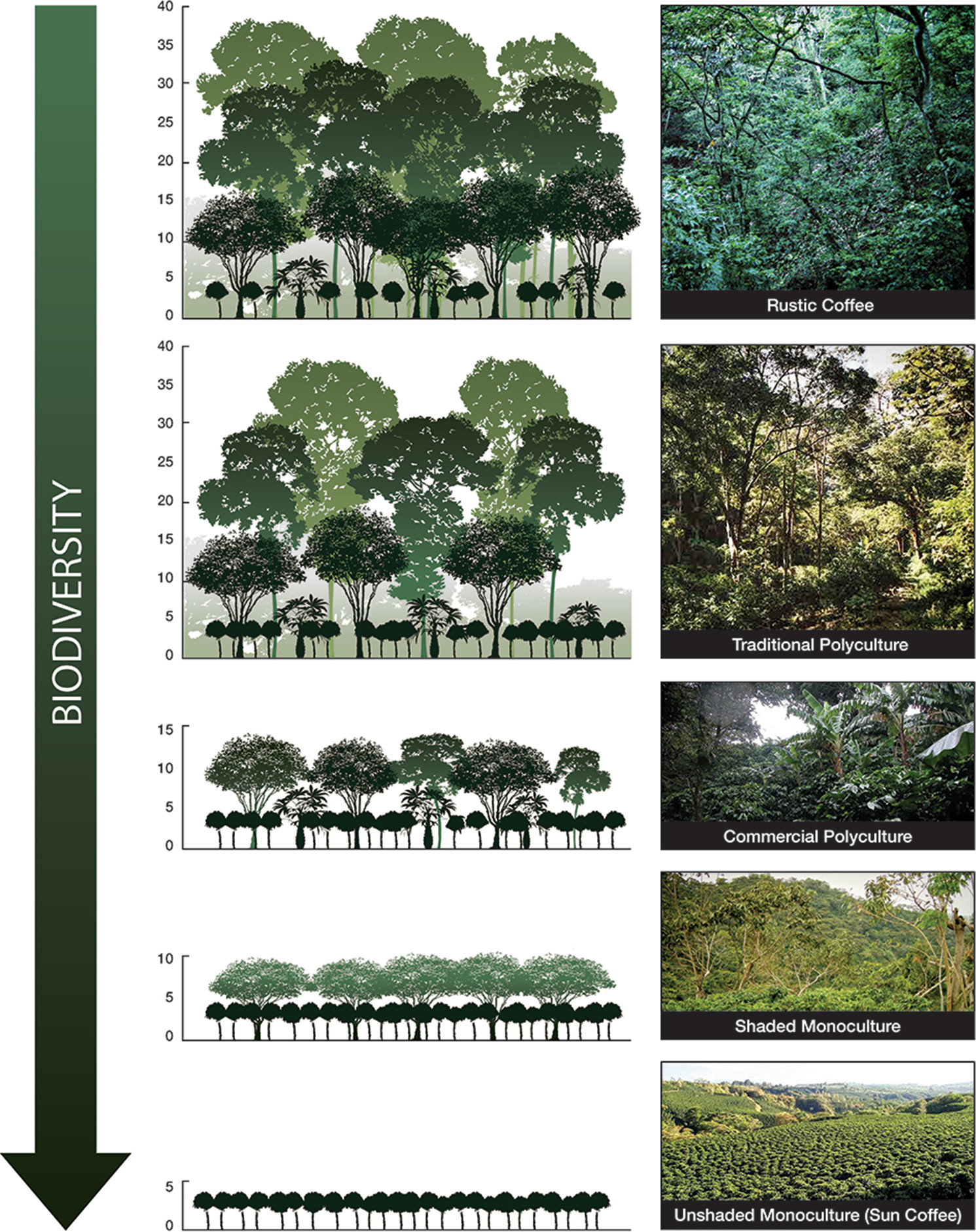
Coffee farming practices typically fall on a gradient that was described in the late 1990s based on practices in Mexico. At one extreme is the “rustic” system wherein coffee is planted in forest understory (top); at the other extreme is an unshaded monoculture of “sun” coffee (bottom). Generally, there is more biodiversity and less agrochemical use toward the rustic end of the spectrum, and the farms are smaller. But there’s a quite a bit of variation in production practices — some large plantations, for example, minimize chemical inputs and maintain shade trees.
CREDIT: I. PERFECTO ET AL / CURRENT ANTHROPOLOGY 2019. GRAPHIC BY D. BRENNER, PHOTOS BY I. PERFECTO.
Given this biological richness, it’s no surprise that there’s growing interest in studying coffee as an agroecosystem — a dynamic bridge between natural and agricultural systems. Such farming methods have the potential not only to help sustain our caffeine fix, but also to provide a bounty of biological richness. The work of Ivette Perfecto has been central to this shift. An ecologist at the School for Environment and Sustainability at the University of Michigan, Perfecto has spent decades studying the diverse assemblage of species that make coffee farms their home, especially some of the smallest farmworkers — the insects.
Historically, biodiversity conservation has focused on the establishment of protected areas like parks and reserves. But agricultural lands, which cover more than twice as much land as such protected areas, can also offer opportunities for conservation. Shaded coffee farms, for example, can serve as refuges that provide quality habitat for wildlife, Perfecto told Knowable Magazine.
This conversation has been edited for length and clarity.
What sparked your interest in studying coffee landscapes?
I became interested in the conservation of biodiversity while a graduate student at the University of Michigan’s School of Natural Resources and Environment [now the School for Environment and Sustainability]. Their strong biodiversity conservation program was focused on establishing protected areas, but I became fascinated by how land outside of protected areas can support biodiversity too.
I’m from Puerto Rico, so I work a lot in Latin America. And I was used to seeing agricultural landscapes rich in wildlife diversity. For my dissertation, I focused on the role of ants in annual cropping systems like milpa corn and beans in Nicaragua.
In the late ’80s to early ’90s, while teaching a course for the Organization for Tropical Studies about managed ecosystems — mostly agricultural systems — I began looking at the diversity of ants and their role in the coffee agroecosystem, comparing a coffee monoculture with a shaded system. That’s when my interest in coffee and biodiversity started.
What was the coffee landscape after it arrived in the Americas?
Coffee cultivation was heavily influenced by colonial powers. When it was introduced in the 1700s, most of the coffee produced was in the plantation or hacienda style. In some parts of the Americas, large coffee estates were established, and enslaved people from Africa were used for labor. After slavery was abolished, local farmers and former slaves were employed to maintain and harvest the coffee.
Not all coffee farms were monocultures though, and in some regions, coffee was grown under shade trees. Interestingly, in Brazil, it was produced in the sun. As for the reason behind this difference, I’m not sure.
In Chiapas, Mexico, where I work, large coffee plantations were established by Europeans who hired local peasants to harvest the coffee. These workers eventually started producing coffee commercially, introducing it to their traditional farming systems. Since many of these farmers were Indigenous people with diverse farming systems, coffee production in small-scale farms tended to be more diverse than in large-scale plantations.
Eventually, there was a shift from growing coffee in the shade of trees toward growing it as a monoculture in the sun. What prompted that shift?
There were several factors, but in Central America in particular there was a big program launched in the 1980s by USAID to intensify coffee farms. The ’80s is known as the lost decade of Latin America because it was a time when a lot of the countries had very high debt. As coffee is a very important economic crop for many Central American countries, the idea was to increase and intensify coffee production. So USAID provided a grant to these countries to stimulate conversion to monocultures and substitute old traditional varieties with new, higher-yielding varieties.
Coffee is an understory plant, and does well under shade trees, but if you expose traditional coffee plants to open sun, they don’t do very well. New varieties were developed that could do well in open areas. But it’s a whole technological package. When you eliminate shade, you eliminate, in many cases, nitrogen-fixing trees — like Erythrina in Costa Rica, or Inga in Mexico. By eliminating these trees, you eliminate sources of soil nitrogen and organic matter, so you then need to apply fertilizers. Weeds also move in. So you apply herbicides. And because it’s a monoculture, that leads to a greater probability of pests, so you apply more pesticides.
So during this era, you had increased use of new coffee varieties, but also rising use of agrochemicals.
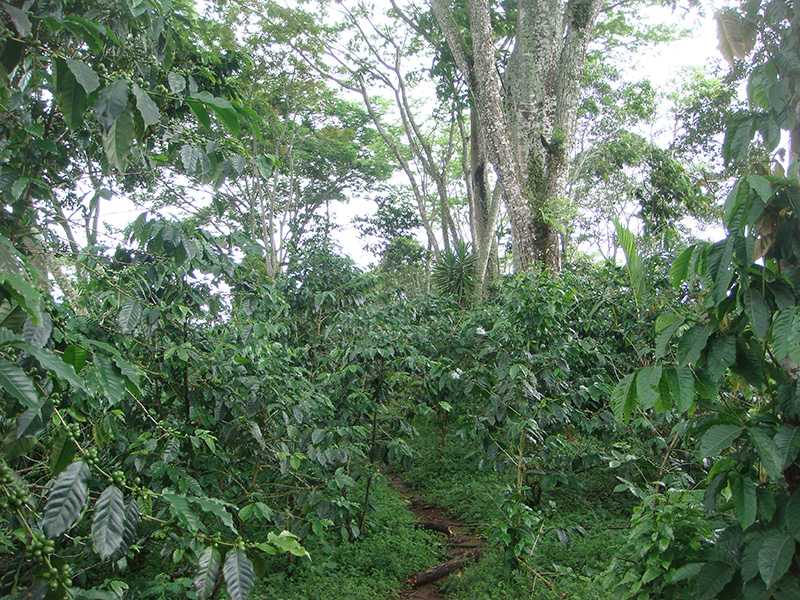
A coffee plantation in Chiapas, Mexico.
CREDIT: PHOTO BY IVETTE PERFECTO / FLICKR
What were some of the biodiversity impacts of this changing coffee landscape?
Some of the earliest impacts were detected in birds. It had become almost common knowledge among birders that to see birds in Latin or Central America, a good place to go was to coffee farms. It’s easier to see the birds there than it is in the forest. But in the late 1980s to early 1990s, the composition of those coffee farms had begun to change as farmers eliminated shade trees.
In the mid-1990s, I was contacted by Russell Greenberg, then director of the Smithsonian Migratory Bird Center, who has sadly since passed away. He had been studying migratory birds in Central America for many, many years. He and others had grown concerned that at the same time that they were witnessing this transformation of increasing intensification of coffee throughout Central America, there were reports of declines in birds in North America — birds that migrate to Central and South America during the wintertime.
Russ contacted me to write a review paper to document links between bird diversity and coffee production, which we published together in BioScience in 1996. In that review of research conducted in the Caribbean Islands, Mexico, Central and South America, we summarized evidence that shade coffee plantations were providing refuge, especially in the dry season, and particularly for forest-dependent migratory birds.
Around the same time, the Smithsonian Migratory Bird Center organized a conference and invited not only ornithologists but a lot of people in the coffee sector. Out of that conference emerged the Smithsonian Bird Friendly coffee certification program. The main philosophy behind the certification was to stimulate the organic farmers that already had very diverse farms not to cut their trees. The rigorous certification criteria include stipulations about the height of canopy, percent foliage cover, diversity of trees, shrubs and surrounding ground plants, buffer zones beside waterways, and allowing leaf litter to feed and protect the soil. The Smithsonian Migratory Bird Center bird-friendly coffee certification scheme still exists today.
As more ecological studies were done in these shifting coffee landscapes, were any broad patterns revealed?
Definitely. The major pattern that emerged was that with increasing intensification comes a decline in species richness or biodiversity. This is a pattern found in many different organisms sampled, and studies have shown that shade coffee can contribute to supporting plant, insect, spider, lizard, bird, bat and mammal diversity. On one of the coffee farms where I work in Mexico, a couple of years ago we saw a baby margay — a species of wild cat fairly rare in this area — so they also use that habitat.
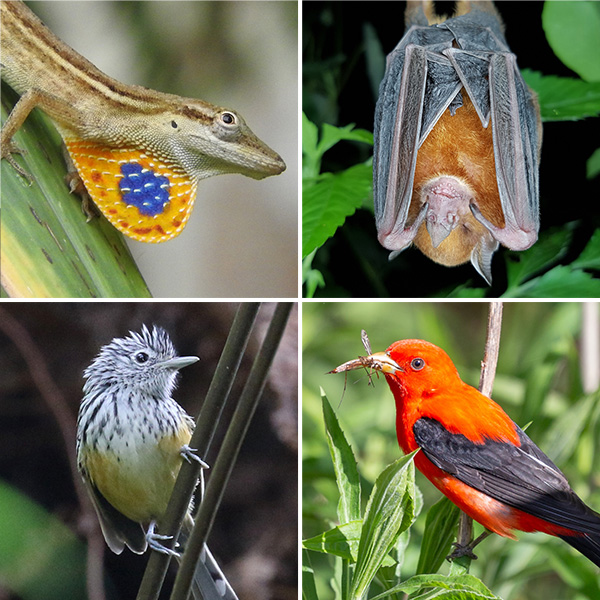
Coffee farms, especially those that maintain shade trees and use fewer agrochemicals, can support a diversity of creatures. These include lizards such as the silky anole (top left), which is predator of the formidable pest, the coffee berry borer; mammals, such as the little yellow-shouldered bat (top right); and birds, including those that overwinter in the south such as scarlet tanagers (bottom right), and locals such as the Santa Marta antbird (bottom left). But coffee farms can’t do it alone: Research suggests that mosaics of farms and intact forest may be key to conservation efforts.
CREDIT, CLOCKWISE FROM TOP LEFT: DAVID MARROQUIN PEREZ, HENRIQUE RABELLO, FLOZADA, GUYINCOGNITO / CC BY-NC
Biodiversity also contributes ecosystem services to coffee production. For example, in one study conducted in Mexico we built structures to keep birds and bats out — to see what would happen in terms of the numbers of herbivorous insects found on coffee plants. My postdoc at the time, Kimberly Williams-Guillén, demonstrated that both bats and birds contribute to reducing these insect pests. The most profound impacts were seen during the wet season, when birds reduced arthropods by 58 percent and bats reduced them by 84 percent.
Healthy ecosystems surrounding coffee might help with reducing the disease impacts too, like rust fungus, which affects the leaves of coffee plants, causing their loss and reducing their ability to photosynthesize and produce energy for flowers that turn into the cherries that we roast as beans.
More recently, we’ve learned that shade coffee farms cannot do the work of biodiversity conservation alone and that it is important to view coffee farms in the context of a broader landscape. Biodiversity is richer when coffee farms exist within a patchwork that includes intact natural habitats, especially forest.
A significant part of that coffee farm biodiversity seems to be ants. What role do they play in coffee agroecosystems?
Ants are just fascinating! My main focus has been on the role of ants as biological control agents — as predators in the system. But being predators is not their only role. Many ants also tend hemipterans — things like aphids and scale insects that feed on plant sap and excrete sugar-rich honeydew. Many species of ants have mutualisms with hemipterans. Ants consume a lot of their honeydew, and in exchange protect hemiptera from enemies like parasitoids or predators.
In Mexico, one of the dominant and aggressive species of ant, Azteca sericeasur, is a tree-dwelling species that nests on shade trees. So if you eliminate the shade trees you eliminate this species. We examined the positive or negative impacts of this ant on an organic coffee farm in Chiapas.
We suspected that these ants could have a negative impact on coffee. Coffee plants surrounded by trees with Azteca nests have a high density of scale insects, a herbivorous coffee pest that reduces yield. These ants are also very nasty to humans, attacking workers pruning coffee trees. Workers deal with this by putting calcium carbonate on nests to calm ants before pruning.
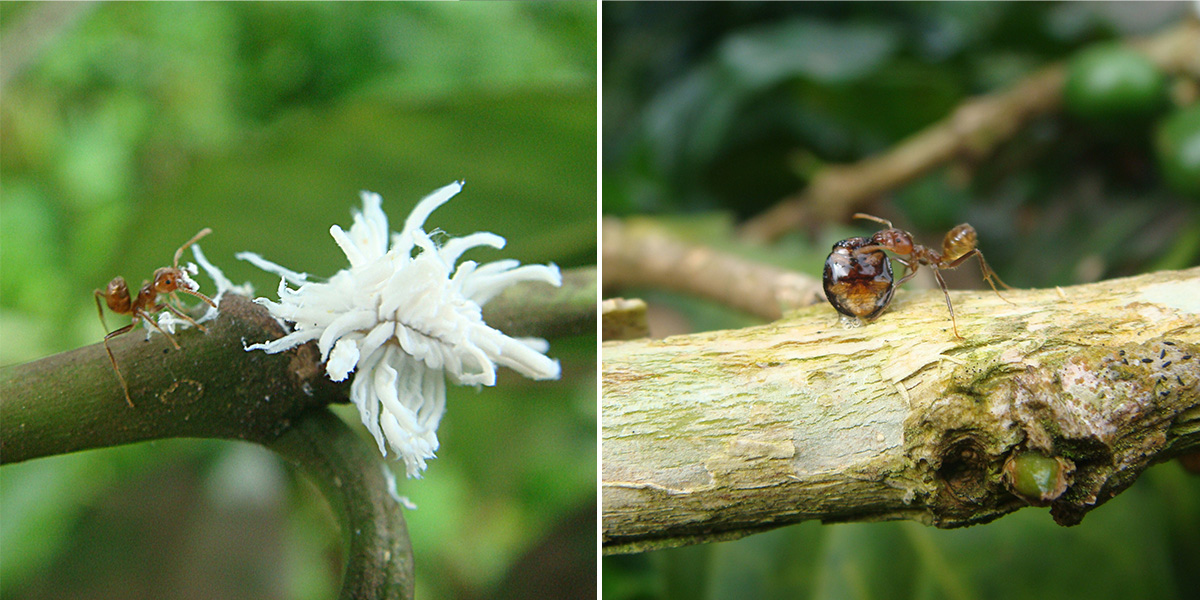
Among the complex interactions found on coffee farms are those involving ants, scale insects and lady beetles. Shown here, an Azteca ant attacks the larva of a lady beetle that’s covered in protective waxy white filaments (left) on a coffee plant in Mexico. Left alone, lady beetles will eat the scale insects; the ants like to keep the scale insects around for the sticky honeydew they provide. An ant grabs an adult beetle (right).
CREDIT: PHOTOS BY IVETTE PERFECTO / FLICKR
But these aggressive ants also attack other pests, including coffee’s main insect pest — coffee berry borer. So coffee plants that have scale insects are better protected from coffee borer than those without, because these are foraging places for ants.
The system is further complicated by other players, including ladybug beetles, white halo fungus and a parasitoid fly that limits ant numbers. In the field and in simulation models, we explored this intricate community dance. We found that close to ant clusters, there is less coffee leaf rust.
Is the ant-coffee interaction different in different places?
Yes. In Puerto Rico, for example, there are hardly any tree-dwelling ants. A lot of the action takes place on the ground. All of the dominant ant species are non-native species. By mapping their distribution on the ground and on coffee plants, one of the things we have documented is an intransitive loop – a term that means competition in a rock-papers-scissors fashion.
People normally think about competition among ant species as a hierarchy: one dominant species, the others subdominant. But in this case, no one species dominates permanently, because once one species starts dominating a particular spot, it gets displaced by another.
So you have this loop that happens over time when you look at ant distribution in the coffee farm. You see one area dominated by one species, another area dominated by another species, and a third area dominated by another. So species A beats species B, species B beats species C, but then species C beats species A. It’s like a rock-paper-scissors game in areas that are constantly fluctuating.
We are looking at the impact of this on pests of coffee because different ant species have different effects on the herbivores feeding on coffee plants. What is the impact of this intransitivity on the pests being controlled by the ants? That’s what we’re trying to find out.
Is there a trade-off for the farmer in terms of maintaining biodiversity on their farms and making a living?
Farmers are of course concerned about yields. If you have coffee surrounded by very dense forest, yield goes down. You can argue that because it is conserving biodiversity, that people should pay more for that coffee and compensate for the lower yield.
A student of mine did a study in Mexico, where she had coffee productivity data for different shade levels. She found that the peak of productivity is the intermediate level of shade. With too much shade, production goes down. But too little shade, and the production also goes down. If you’re a small-scale farmer that doesn’t use herbicide — because when you don’t have any shade, the farm gets covered with weeds and vines that are very hard to control — then you need to be there all the time cutting the weeds and vines. So you have a hump-shaped curve for productivity and the peak of productivity is between 40 to 60 percent shade.
You created a board game for coffee farmers? How was it received?
Yes, we developed a game that’s called the Azteca chess game, named after the Azteca ants. The two-person game was designed to help small-scale Mexican coffee farmers better understand the complex interactions between insects and fungi living on coffee plants — and how some of those creatures can help provide natural pest control. In the game, one player is the ant and wasp, the other player is the beetle larva and adult. As these insects, they move around the board by seeking out the resources they need to survive. The beetle wins if it manages to eat all six scale insects on the board. The ant and the parasitoid win if they manage to defeat all the beetles before beetles consume all the scale insects.
Farmers were excited to participate in these workshops and to see that the game included organisms that they recognize from their farms. They also commented on how the game helped them have a deeper knowledge of how these animals interacted with each other in nature. We also evaluated their ability to remember the positive and negative interactions among the organisms in the game and found that after playing the game, their ability to remember the animals and their interaction increased significantly when compared to simply receiving the information through a PowerPoint presentation.
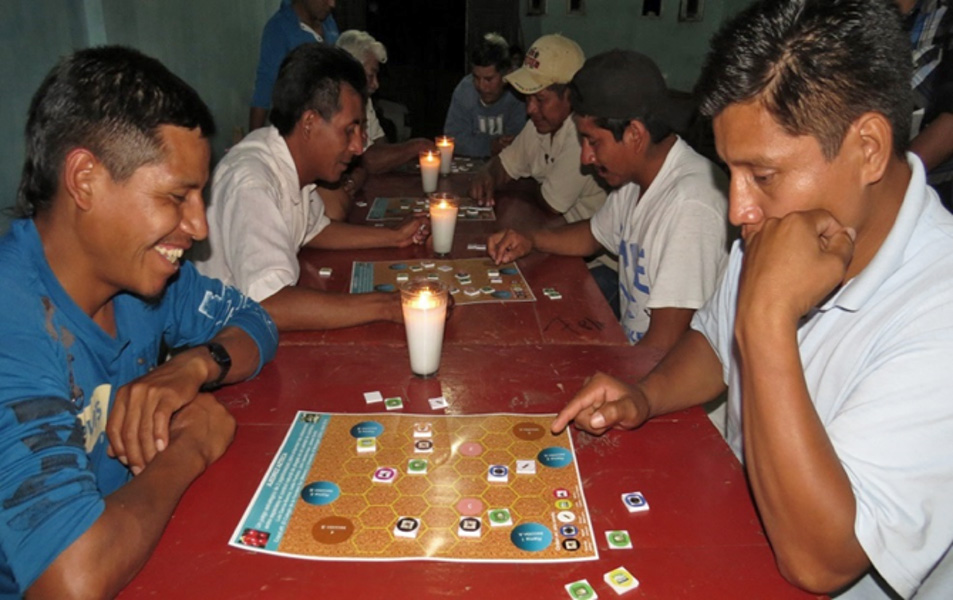
Small coffee producers play the Azteca chess game in a workshop in southern Mexico.
CREDIT: LUIS GARCIA BARRIOS
What do you hope to see in the future?
I would like to see the coffee farmers, first of all, eliminate the use of agrochemicals. I think it’s possible. I work on an organic coffee farm that has been organic for 50 years or more.
Then, plant a diversity of shade trees, and if you can, produce a diversity of things, not just coffee but other crops. That would be good for the farmers as well, because they don’t have to rely on this commodity for which they have no control over price. Producing more things promotes biodiversity and buffers them against big price fluctuations.
Our research shows that planned biodiversity — what the farmer intentionally includes in the system — has a positive relationship with overall biodiversity. The more diversity of organisms or crops you have there, the more diversity of wildlife you’re going to have.
Given your in-depth understanding of coffee agroecosystems, what goes through your mind when you take a sip?
I think a lot about the coffee ecosystem as one that is potentially so diverse that it can help maintain biodiversity at the landscape level.
That’s what I think about: How was this coffee produced?
10.1146/knowable-011824-2
TAKE A DEEPER DIVE | Explore Related Scholarly Articles





